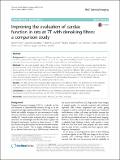| dc.contributor.author | Tricot, Benoit | en_US |
| dc.contributor.author | Descoteaux, Maxime | en_US |
| dc.contributor.author | Dumont, Matthieu | en_US |
| dc.contributor.author | Chagnon, Frederic | en_US |
| dc.contributor.author | Tremblay, Luc | en_US |
| dc.contributor.author | Carpentier, André | en_US |
| dc.contributor.author | Lesur, Olivier | en_US |
| dc.contributor.author | Lepage, Martin | en_US |
| dc.contributor.author | Lalande, Alain | en_US |
| dc.date.accessioned | 2018-01-18T02:27:15Z | |
| dc.date.issued | 2017 | en_US |
| dc.identifier.citation | Tricot, Benoit, Maxime Descoteaux, Matthieu Dumont, Frederic Chagnon, Luc Tremblay, André Carpentier, Olivier Lesur, Martin Lepage, and Alain Lalande. 2017. “Improving the evaluation of cardiac function in rats at 7T with denoising filters: a comparison study.” BMC Medical Imaging 17 (1): 62. doi:10.1186/s12880-017-0236-2. http://dx.doi.org/10.1186/s12880-017-0236-2. | en |
| dc.identifier.issn | | en |
| dc.identifier.uri | http://nrs.harvard.edu/urn-3:HUL.InstRepos:34651868 | |
| dc.description.abstract | Background: We investigate the use of different denoising filters on low signal-to-noise ratio cardiac images of the rat heart acquired with a birdcage volume coil at 7T. Accuracy and variability of cardiac function parameters were measured from manual segmentation of rat heart images with and without filtering. Methods: Ten rats were studied using a 7T Varian system. End-diastolic and end-systolic volumes, ejection fraction and left ventricle mass (LVM) were calculated from manual segmentation by two experts on cine-FLASH short-axis slices covering the left ventricle. Series were denoised with an anisotropic diffusion filter, a whole variation regularization or an optimized Rician non-local means (ORNLM) filtering technique. The effect of the different filters was evaluated by the calculation of signal-to-noise (SNR) and contrast-to-noise (CNR) ratios, followed by a study of intra- and inter-expert variability of the measurement of physiological parameters. The calculated LVM was compared to the LVM obtained by weighing the heart ex vivo. Results: The SNR and the CNR increased after application of the different filters. The performance of the ORNLM filter was superior for all the parameters of the cardiac function, as judged from the inter- and intra-observer variabilities. Moreover, this filtering technique resulted in the lowest variability in the LVM evaluation. Conclusions: In cardiac MRI of rats, filtering is an interesting alternative that yields better contrast between myocardium and surrounding tissues and the ORNLM filter provided the largest improvements. | en |
| dc.language.iso | en_US | en |
| dc.publisher | BioMed Central | en |
| dc.relation.isversionof | doi:10.1186/s12880-017-0236-2 | en |
| dc.relation.hasversion | http://www.ncbi.nlm.nih.gov/pmc/articles/PMC5735834/pdf/ | en |
| dash.license | LAA | en_US |
| dc.subject | Small animal | en |
| dc.subject | Non-local means filtering | en |
| dc.subject | Cine-MRI | en |
| dc.subject | Denoising | en |
| dc.title | Improving the evaluation of cardiac function in rats at 7T with denoising filters: a comparison study | en |
| dc.type | Journal Article | en_US |
| dc.description.version | Version of Record | en |
| dc.relation.journal | BMC Medical Imaging | en |
| dc.date.available | 2018-01-18T02:27:15Z | |
| dc.identifier.doi | 10.1186/s12880-017-0236-2 | * |


